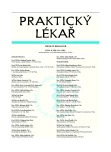Occurrence of symptoms and risk factors for obstructive sleep apnea in patients examined for cardiac arrhythmias through Holter ECG monitoring
Authors:
E. Sovová 1,3; M. Hobzová 2; Marek Sova 4; V. Kolek 2; I. Buriánková 1; P. Zmeškal 1
Authors‘ workplace:
Fakultní nemocnice Olomouc a Lékařská fakulta
Univerzity Palackého v Olomouci
; I. interní klinika
Přednosta: doc. MUDr. Miloš Táborský, CSc., MBA
1; Klinika plicních nemocí a tuberkulózy
Přednosta: prof. MUDr. Vítězslav Kolek, DrSc.
2; Klinika tělovýchovného lékařství a kardiovaskulární rehabilitace
Přednostka: doc. MUDr. Eliška Sovová, Ph. D., MBA
3; Lékařská fakulta Univerzity Palackého v Olomouci
Děkan: prof. MUDr. Zdeněk Kolář, CSc.
4
Published in:
Prakt. Lék. 2010; 90(8): 469-471
Category:
Of different specialties
Overview
Aim:
Cardiac arrhythmias are more prevalent in patients with obstructive sleep apnea (OSA).
Very little data is currently available about the incidence of OSA in patients examined for cardiac arrhythmias. The aim of the study was to evaluate the incidence of symptoms and risk factors of OSAin patients examined for cardiac arrhythmias and to perform polysomnography in symptomatic patients.
Methods and results:
177 patients (82 males, 95 females) of average age 59.31 (59.79 for men and 59.31 for women) underwent Holter ECG monitoring for history of cardiac arrhythmias and filled out a simple questionnaire relating to symptoms and risk factors of OSA.After the first 100 patients were evaluated, the following 44 patients (19 male, 25 female) with more than 2 symptoms of OSA were referred for polysomnography.
Conclusion:
High prevalence of symptoms and risk factors of OSA have been confirmed: snoring in 70 patients (39 male) (39.54 %), apneas in 15 patients (9 male) (8.47 %), tiredness in 80 patients (30 male) (45.19 %), microsleep in 70 patients (27 male) (39.54 %). Only 12.99 % physicians asked patients about their sleep problems. Of the 44 patients referred for polysomnography only 14 patients (6 male) (31.81 %) turned up; OSA was confirmed in 3 patients (1 male) (21.4 % of those examined).
Key words:
obstructive sleep apnea, symptoms and risk factors, arrhythmias, Holter ECG monitoring.
Sources
1. Bradley, T.G., Floras, J.S. Obstructive sleep apnea and its cardiovascular consequences. Lancet 2009, 373, p. 82-93.
2. Braga, B., Poyares, D., Cintra, F. et al. Sleep disordered breathing and chronic atrial fibrillation. Sleep. Med. 2009, 10(2), p. 212-216.
3. Devulapally, K., Pongonis, R., Khayat, R. OSA: the new cardiovascular disease: part II: Overwiew of cardiovascular diseases associated with obstructive sleep apnea. Heart Fail. Rev. 2009, 14(3), p. 155-164.
4. Garrigue, S., Pépin, J.L., Defaye, P. et al. High prevalence of sleep apnea syndrome in patients with long term pacing. The European multicenter polysomnographic study. Circulation 2007, 115, p. 1703-1709.
5. Hersi, A.S. Obstructive sleep apnea and cardiac arrhythmias. Ann. Thorac. Med. 2010, 5(1), p. 10-17.
6. Hobzová, M. Obstrukční spánková apnoe. Interní medicína pro praxi 2010, 12(3), s. 148-151.
7. Mehra, R., Benjamin, E.J., Shahar, E. et al. Association of nocturnal arrhythmias with sleep disordered breathing: the Sleep Heart Health Study. Am. J. Respir. Crit. Care Med. 2006, 173(8), p. 910-916.
8. Muller, A., Fietze, I., Voelker, R. et al. Screening for sleep-related breathing disorders by transthoracic impedance recording integrated into Holter ECG systém. J. Sleep. Research 2006, 15(4), p. 455-462.
9. Nevšímalová, S., Šonka, K. Poruchy spánku a bdění. Praha: Galén 2007, 345 s.
10. Somers, V.K., White, D.P., Amin, R. et al. Sleep apnea and cardiovascular disease: An American Heart Association/American College of Cardiology Foundation Scientific Statement from the American Heart Association Council for High Blood Pressure Research Professional Education Commitee, Council on Clinical Cardiology, Stroke Council, and Council on Cardiovascular Nursing In Collaboration With the National Heart, Lung, and Blood Institute National Center on Sleep Disorders Research (National Institute of Health). J. Am. Coll. Cardiol. 2008, 52, p. 686-717.
11. Szyszko, A., Franceschini, C., Gonzales-Zuelgaray, J. Reliability of a Holter based methodology for evaluation of sleep apnoea syndrome. Europace 2009, 11(1), p. 94-99.
12. Šonka, K., Slonková, J. Spánková apnoe dospělého věku. Česk. Slov. Neurol. N. 2008, 71/104(6), s. 643-656.
13. Šonka, K. Poruchy dýchání vázané na spánek u dospělých. Prakt. Lék. 2007, 87(6), s. 319-327.
14. Young, T., Peppard, P.E., Gottlieb, D.J. Epidemiology of obstructive sleep apnoea: a population health perspective. Am. J. Respir. Crit. Care Med. 2002, 165, p. 1217-1239.
Labels
General practitioner for children and adolescents General practitioner for adultsArticle was published in
General Practitioner

2010 Issue 8
Most read in this issue
- Spontaneous intracranial hypotension
- Zinc and its relation to prostate tumours
- Human biomonitoring – its importance and application for evaluating population exposure to environmental chemicals (toxins)
- Physical activity as a part of cardiovascular disease prevention in the general practitioner’s surgery
